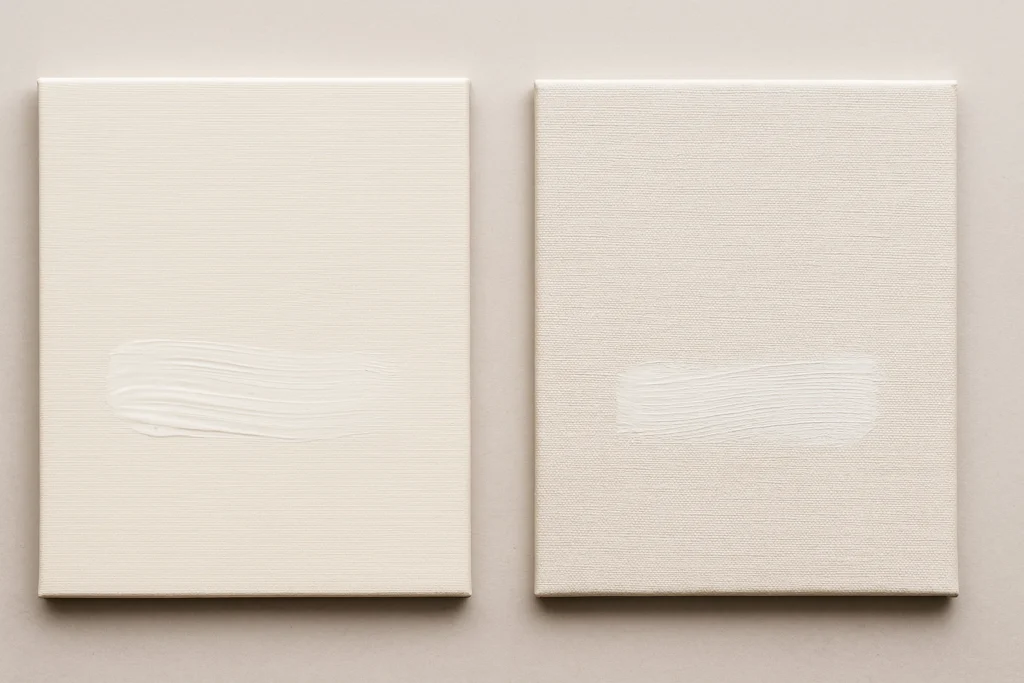Oil-Primed Linen vs Acrylic-Primed Linen: The Surface That Makes or Breaks Your Painting
When it comes to painting surfaces, choosing Oil-Primed or Acrylic-Primed linen impacts your brushwork, durability, and the long-term quality of your art.
It is not that one is universally better than the other; depending on your technique, medium, and standards for quality, one will clearly come out ahead. I will break it down.
What is the Actual Difference?
Acrylic primed linen is sealed and primed with several layers of acrylic gesso, typically made of titanium white pigment in an acrylic polymer emulsion. This is a perfect general surface to work with. The texture improvements come from the weave of the fabric. We use Acrylic-Primed Belgian Linen on Hardwood Panels, which has texture but with a tighter weave than canvas. It dries quickly, feels slightly absorbent, and works for oil, acrylic, or mixed media. Acrylic priming adds enough tooth for solid adhesion. The linen weave beneath still lets the paint flow with a touch of luxury.
Alternatively, Oil-Primed Linen is sized with either an oil-based or alkyd sealer, then primed with multiple coats of an oil ground, often lead or titanium-based. If you do not use oil paint or have the patience for the process, then this product is not for you. It is only for oil paint and takes longer to cure, but the results speak for themselves. If you like a toothy surface for your oil paintings, stick with the acrylic primed linen. This is the surface to choose if you enjoy creating oil paintings with extra fine detail. It is also incredible for glazing and subtle blending that will last for generations.
| Feature | Acrylic Primed Linen | Oil Primed Linen |
|---|---|---|
| Mediums supported | Oil, acrylic, mixed media | Oil paint only |
| Ground material | Acrylic gesso | Oil ground |
| Drying time | Fast | Slow (weeks to fully cure) |
| Feel | Absorbent, matte | Smooth, slick |
| Archival quality | Moderate | High |
| Cost | $$ | $$$ |
How They Feel Under the Brush
You will notice it instantly. Acrylic primed linen has a draggy, toothy surface. The brush resists a little, especially when using soft paint. Some painters like the feedback. Others, not so much.
Oil primed linen, in contrast, feels buttery. There is a glide that makes blending smoother, glazes easier, and brushwork more elegant. Palette knives slide cleanly. It is a subtle but addictive upgrade, especially for those who like classical techniques or layered painting.
Which One Lasts Longer? The Archival Debate
Here is where it gets serious. Oil ground is chemically more compatible with oil paint, forming a cohesive film that cures together and moves similarly over time. This reduces the risk of cracking, delamination, or embrittlement after the paint has cured. It is the classic pairing used in countless museum-caliber works over the past few centuries.
Acrylic-primed linen, often marketed as universal, is flexible and fast-drying, but conservation studies have raised concerns. Over long periods, some works have shown increased risk of adhesion failure, flaking, and cracking, particularly when the artist uses oil paint, thick impasto, or skips oiling out before later layers. Acrylic does not form the same chemical bond with oil paint that oil ground does, which can result in long-term instability.
The Canadian Conservation Institute and other preservation bodies have noted that oil on acrylic gesso may not age as predictably or durably, especially under mechanical or environmental stress.
One Fix: Mounting Acrylic-Primed Linen to Panels
Nevertheless, when acrylic-primed linen is adhered to a rigid support, such as aluminum composite (ACM) or properly sealed birch, its long-term archival performance improves substantially.
Why?
Because canvas flexing is the enemy of oil paint. Every time a stretched canvas moves during transport, handling, or humidity shifts, it stresses the paint film. Over the decades, that movement can lead to microcracks or worse. Mounting to a panel eliminates this flex.
A rigid, sealed support helps stabilize both the ground and the paint, minimizing cracking, lifting, or surface failure over time.
So if you are choosing acrylic-primed linen for its affordability or versatility, mounting it to a rigid panel gives you the best of both worlds: creative flexibility now and structural integrity for the long haul.
What About Cost and Accessibility?
Oil primed linen is more expensive. Brands like Claessens, ArtFix, and Belle Arti all make excellent oil-primed rolls and panels; however, they are pricier and often only found in specialty stores.
Acrylic primed linen is more affordable and easier to find. A variety of brands are available at big-box art stores and online, but quality can vary.
I personally use Claessens #9 oil-primed linen for my best panels. I stock up when it is on sale. It’s luxurious, archival, and honestly, my brush feels weird on anything else now.
So Which One Should You Use?
If you’re a beginner, experimenting with mediums, or on a limited budget, go with acrylic primed linen. It’s forgiving, flexible, and offers good value if you buy from a quality source.
For artists committed to oil painting, fine detail, museum-grade longevity, and the tactile elegance of a master’s surface, oil-primed linen remains unmatched.
Oil primed wins for serious oil painters. You’ll pay more, but your brush and your legacy will thank you.
Bonus Tip: Do a Side-by-Side Test
Want proof? Grab a panel of each, tone them the same, and paint identical passages. You’ll feel it. Thanks to its slick, oil-compatible surface, oil-primed linen draws paint into smooth blends and luminous layers that almost paint themselves.
Coming Soon
We’re working on a post called “How to Test If Your Panel Is Really Archival” with tips for checking pH, moisture absorption, and UV reaction. Subscribe to the list and we’ll send it to you when it drops.




